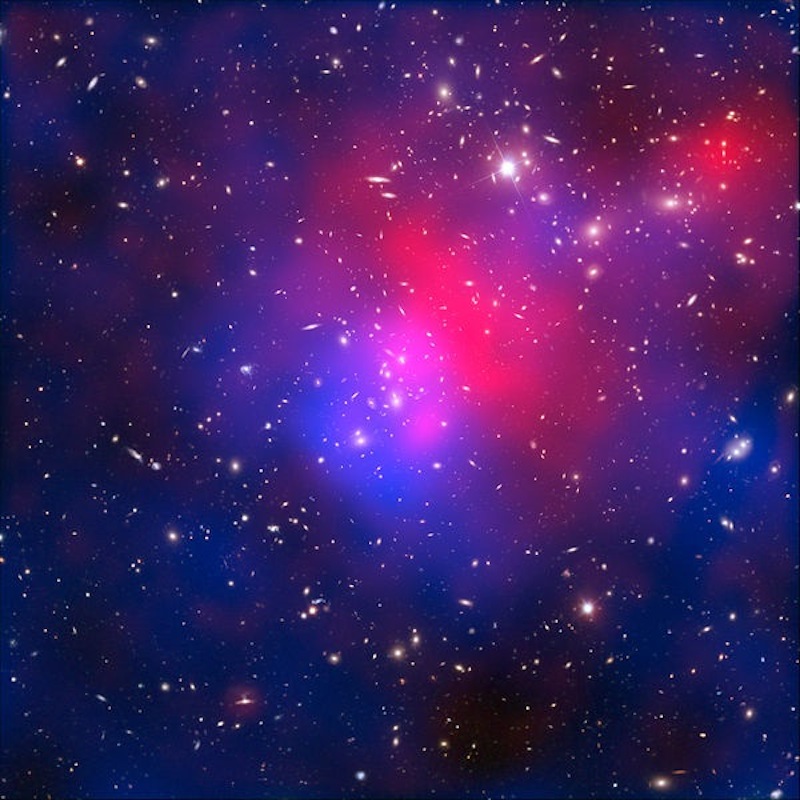Invisible Dark Matter May Show Up in GPS Signals

GPS satellites are crucial for navigation, but now researchers think this technology could be used for an unexpected purpose: finding traces of enigmatic dark matter that is thought to lurk throughout the universe.
Physicists estimate there is nearly six times as much dark matter in the universe as there is visible matter. But despite a decades-long search, scientists have yet to find direct evidence of invisible dark matter, and its existence is inferred based on its gravitational pull on galaxies and other celestial bodies. Without the extra force of gravity from dark matter, researchers say, galaxies wouldn't be able to hold themselves together.
Physicists don't know what dark matter is made of, but some think it's composed of particles that barely interact with the visible world, which is why dark matter is invisible and has been difficult to detect. [The 9 Biggest Unsolved Mysteries in Physics]
However, Andrei Derevianko, a professor of physics at the University of Nevada, Reno, and Maxim Pospelov, a professor of physics and astronomy at the University of Victoria, British Columbia, have proposed that dark matter isn't made of particles at all. The researchers think dark matter may be a topological defect — a kind of tear in the fabric of space-time that can't be repaired. They think these patches of dark matter drifting by could interrupt GPS satellites and atomic clock systems.
To search for the theoretical patches of dark matter, the team is using GPS data from the Geodetic Lab, in Reno, that pulls in data from more than 12,000 GPS stations around the world. In particular, the researchers are focusing on GPS satellites that use atomic clocks for navigation.
GPS satellites orbiting above Earth and their ground-based networks have synchronized clocks, and Derevianko and Pospelov think when clumps of dark matter drift by, they could cause interference between the two.
"The idea is, where the atomic clocks go out of synchronization, we would know that dark matter, the topological defect, has passed by," Derevianko said in a statement. "In fact, we envision using the GPS constellation as the largest human-built dark-matter detector."
Get the world’s most fascinating discoveries delivered straight to your inbox.
It shouldn't take much to detect dark matter blowing by, the researchers said. It would only need to desynchronize the clocks by slightly more than a billionth of a second. The researchers also think these theoretical dark matter clumps travel at different speeds than other phenomena that could similarly desynchronize atomic clocks, such as solar flares. The different speeds would have different effects on the atomic clocks, the scientists said.
Glenn Starkman, a professor of physics and astronomy at Case Western Reserve University in Cleveland, Ohio, who was not involved with the research, said it makes sense to first search for dark matter within the limits of the Standard Model, the reigning theory of particle physics that outlines how the universe should behave. This means looking for dark matter particles, not clumps, Starkman told Live Science. But, researchers working at underground particle detectors and the Large Hadron Collider (LHC), the world's largest atom smasher, where the once-elusive Higgs boson was discovered, have so far failed to find any dark matter particles.
An unusual idea like this one could help spark some alternative ideas for what makes up dark matter, said Dan Hooper, a researcher at the Fermi National Accelerator Lab in Illinois, who was also not involved with the study. That is, Hooper said, if physicists don't spot dark matter particles in the next couple of years.
Follow Kelly Dickerson on Twitter. Follow us @livescience, Facebook & Google+. Original article on Live Science.

